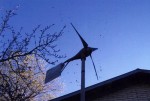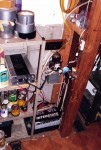Using Waldon Pond as a guide and an early Banner motor home as an inspiration, 22+ years ago I wired my 2,000 square foot home for 12-volt and 110-volt solar emergency lighting and light work.

Pictured is the home-built control center for the three panel system, which is 100 watts. The 300 watt wind turbine can be used for pumping water when hooked to the single battery or it may be used to charge a neighbor’s battery for barter.

A short-run gas generator (110 volt 22 amp) handles the heavy loads when the grid is down and is disconnected from the home wiring. (This is entirely seperate from the solar electric wiring.) The gas generator is used about two hours per month, as I have use of a propane refrigerator, a window box, hand tools, a non-electric heating system, and a camp stove. This greatly simplifies fuel storage for the generator and maintance.

In summer, I have customized this emergency electrical system to meet my expectations and needs. It’s not fancy or expensive, but it will allow me to work and live.
Over these 22+ years, I have noticed that replacing large banks of lead acid type batteries can account for 1/2 to 3/4 of the total cost of the solar electrical system.
LED light and a volt meter (not pictured) allow me to moniter my electric usage and not deep cycle my battery, which is a take out from a friend’s truck. He upgraded at five years, and I have used it two additional years in my home.

All but one of my solar panels was acquired used. The 12-year-old air marine was acquired through traded. The mast came from the used metal yard for $7, as were my glory pile, base, and braces. I made two solar panel mounts and bought the third from Harbor Fraight. I bought two inverters new, and paid only $10 at a swap meet for a regulator. I did the wiring and instillation myself. Yes, a small solar electric system can be affordable. I was tempted to by a RV solar add-on kit, but I didn’t.









